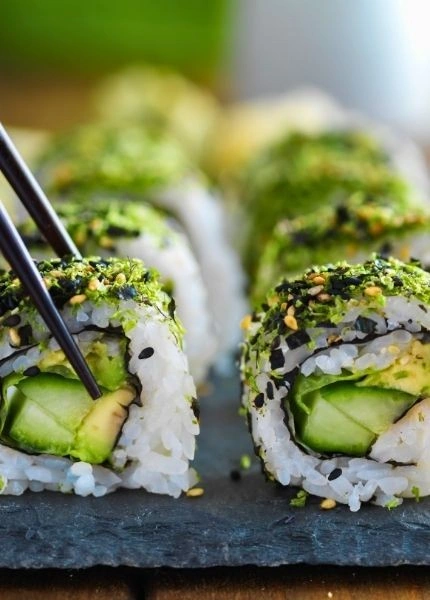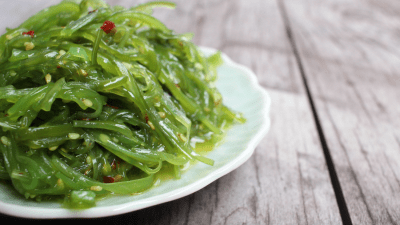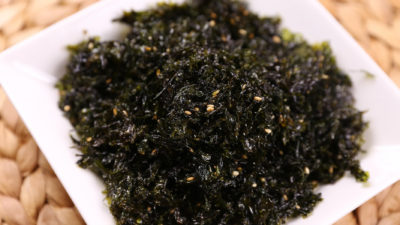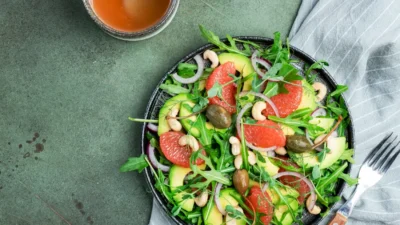Seaweed uncovered
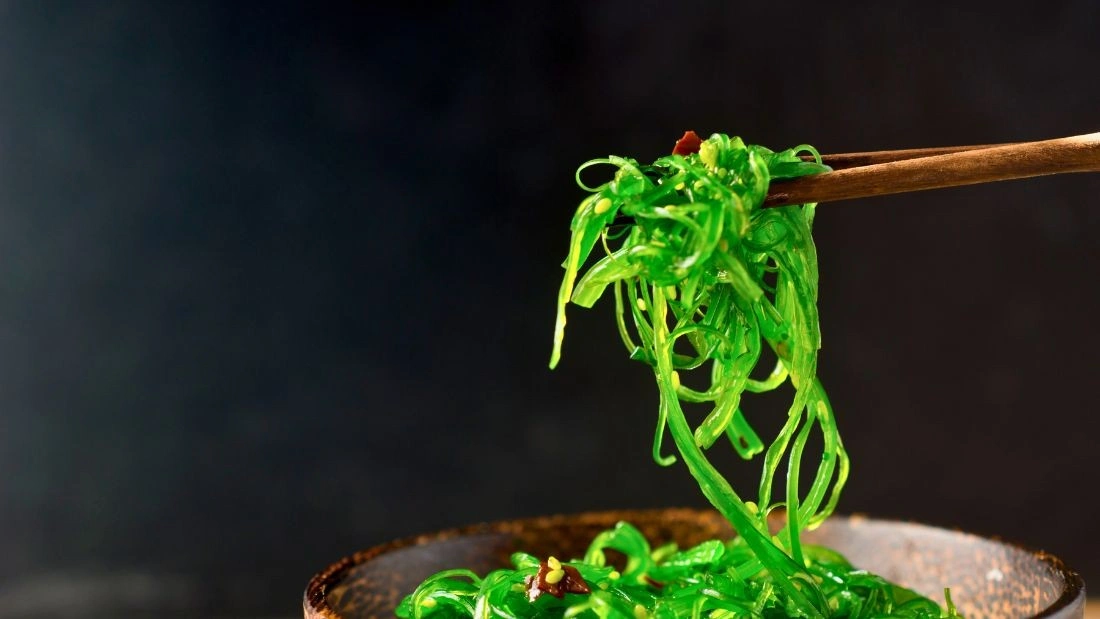
Your guide to iodine, gut health and green nutrition.
Once popular with ancient Europeans but now largely forgotten, seaweed is being rediscovered as a powerhouse ingredient. Rich in vitamins, minerals and antioxidants, it supports everything from thyroid and heart health to digestion and blood sugar balance. In places such as Okinawa, Japan – famed for its many centenarians – seaweed remains a daily staple, offering a glimpse of its potential to promote longevity.
Seaweed is a general term for thousands of species of macroscopic, multicellular, marine algae, including red (Rhodophyta), brown (Phaeophyta) and green (Chlorophyta) macroalgae. They provide essential habitats for marine species and play a crucial role in mitigating climate change. Kelp forests, for example, are called the ‘rainforests of the sea’ because they support a wide variety of marine life, including fish, crustaceans, molluscs and many other sea creatures. Planktonic algae, on the other hand, float freely in the water and play a vital role in capturing carbon and producing at least 50 per cent of Earth’s oxygen.
Seaweed supper
As well as its crucial role in marine ecosystems, archaeological evidence shows that seaweeds have been an important part of some human diets since ancient times. A study published in Nature Communications reveals that seaweeds were eaten in the Mesolithic period, through the Neolithic transition to farming and into the Early Middle Ages. More than 145 varieties are now eaten, but most of that occurs in Asian countries such as Japan, China, Korea and Taiwan – in Europe, seaweed consumption is much lower.
Nutritional and health benefits
Some of the most common edible seaweeds include wakame, kelp, nori and arame. Their nutritional content varies based on what type it is and where it grows. Generally, seaweeds provide a low-calorie source of iodine and fibre along with varying amounts of vitamins A, C, E and K, folate, zinc, sodium, calcium and magnesium.
Seaweeds contain unique polysaccharides (complex carbohydrates or sugars) that encourage the growth of our ‘good’ gut bacteria and increase the production of short-chain fatty acids which in turn promote good gut health, digestion, immune function and overall wellbeing.
Antioxidant and anti-inflammatory properties
Antioxidants protect your body’s cells from free radical damage. In addition to its antioxidant vitamins A, C and E, seaweeds boast a wide variety of beneficial plant compounds, including antioxidant flavonoids and carotenoids, which give them their bright colours. The carotenoid fucoxanthin, for example, is found in brown algae such as wakame and has over 10 times the antioxidant capacity of vitamin E. Together, these effects may support cardiovascular health, aid muscle repair, enhance metabolic efficiency and promote overall physical fitness and wellbeing.
Seaweeds, especially red and brown varieties, also contain very small amounts of the omega-3 fats eicosapentaenoic acid (EPA) and docosahexaenoic acid (DHA), which may help combat inflammation. Fish obtain their omega-3s by consuming plankton, algae and other fish that have eaten these natural, omega-3-rich sources. To ensure a reliable intake of EPA and DHA omega-3s while avoiding the risk of toxins such as mercury, dioxins and PCBs that can accumulate in fish, consider taking an algal supplement.
Iodine and Thyroid Support
Your thyroid gland is a small, butterfly-shaped organ located at the front of your neck. It produces hormones that regulate how quickly your body uses the energy from food. To make the important hormone thyroxine, the thyroid needs iodine.
Low levels of iodine can result in a goitre (enlarged thyroid gland) or if the lack of iodine is very severe, hypothyroidism – an underactive thyroid. In the UK, iodine deficiency as a cause of hypothyroidism is rare because even poor diets generally provide enough iodine, mainly from dairy products (see below), seafood and cereals.
The NHS says adults need 140 micrograms (μg) of iodine a day and that most people should be able to get all the iodine they need by eating a varied and balanced diet. On the other hand, too much iodine can disrupt thyroid function. Daily intakes up to about 500 μg are generally considered safe for most people.
Seaweeds are one of the richest food sources of iodine, but contents vary widely depending on the type and how it is prepared (eg fresh, dried or cooked). A five-gram serving of Clearspring’s Japanese Wakame Flakes contains about 590 µg of iodine – slightly above the daily recommended top limit, so use sparingly. Similarly, 100 grams of stock made with Kombu (edible kelp) has 456 µg, nearing the upper limit. One 2.5-gram sheet of Clearspring’s Japanese Nori provides 368 µg and a 30-gram cooked serving of Japanese Arame contains 453 µg of iodine. So, while seaweed can be a great source of iodine, it’s a good idea to vary your intake and not consume large amounts regularly to maintain a healthy intake.
Dairy is not a natural source of iodine
Iodine has been used as an antiseptic to treat wounds for over 170 years. Dairy cows are prone to udder infections (mastitis), so their teats are routinely washed with iodine-based disinfectants, which is how some iodine ends up in their milk. The dairy industry often promotes cow’s milk as a good source of iodine, but this iodine isn’t naturally present – it comes from supplements added to cattle feed and from the iodine in disinfectant teat dips and udder washes. Meanwhile, many plant-based milks are now fortified with iodine, a preferable source than teat dips!
Sustainability of Seaweed Farming
Seaweed farming is highly sustainable compared to land-based agriculture. It requires no land, freshwater, fertilisers, pesticides or herbicides, making it environmentally low-impact and resource-efficient. Seaweed absorbs carbon dioxide from ocean waters, acting as a carbon sink and helping reduce ocean acidification. This not only helps combat climate change but also supports marine biodiversity.
How to use seaweed
There are many ways to add seaweed to your diet, including:
- Seaweed snacks: dried seaweed sheets or flakes make tasty, convenient snacks or toppings
- Seaweed salad: fresh or rehydrated seaweed varieties such as wakame or arame make great salads with a light dressing
- Vegan sushi: wrap avocado, carrot, cucumber and ginger-covered sticky rice rolls with toasted nori sheets
- Ramen and other noodle dishes: use kombu-based stock to add flavour to this popular Japanese noodle soup
- Vegan ‘fish’ dishes: use seaweed creatively as a base ingredient in vegan fishcakes or battered ‘fish’ (using tofu or banana blossom), for a taste reminiscent of seafood
- Stir-fries: toss rehydrated arame or wakame with vegetables in stir-fries for a natural umami flavour
- Paella: add strips of arame for a subtle seafood flavour in this Spanish classic
Check the nutritional information on the packet to ensure you do not consume too much iodine.
These are just a few of the many delicious ways to savour the flavours of the sea – without the cruelty or environmental harm caused by fishing – while reaping the abundant health benefits that seaweed has to offer. See veganrecipeclub.org.uk for more seaweed recipes!
